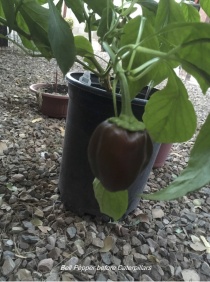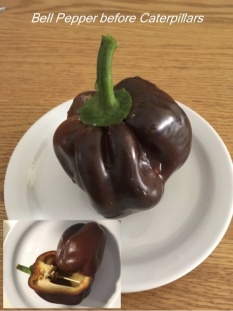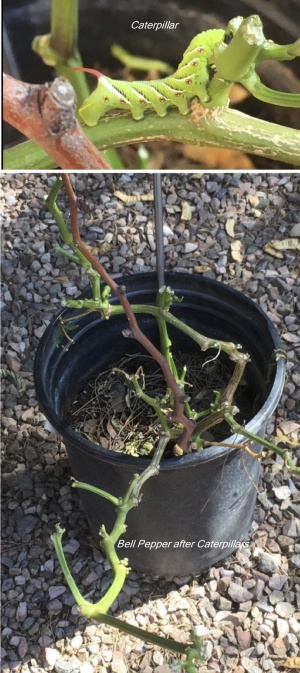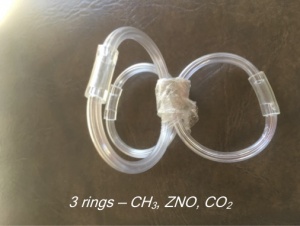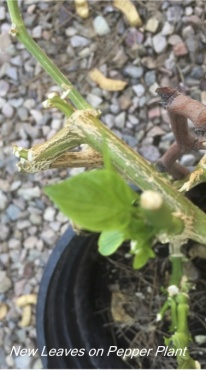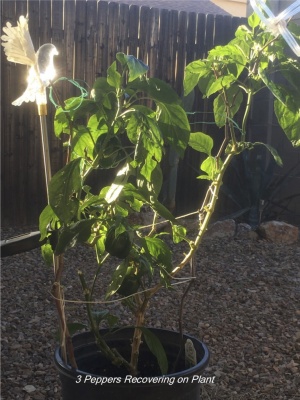Chocolate Bell Pepper Plant—A testimonial
This article is part of the KF Plasma Times March 2019
This is a testimonial describing how Plasma Science and Technology, through use of Plasma waters made with various GANSes, restored a Chocolate Bell Pepper plant to full health.
The purpose is to bring a solution that will assist others with a similar need.
Plant History and Background
In March 2017 I purchased a non GMO Chocolate Bell Pepper plant from an established local family owned nursery. It was a young healthy plant.
Containers are used for gardening because I cannot put plants into the ground in my location. The summer temperatures can reach 105 – 115 or more degrees Fahrenheit on a daily basis.
For this reason I use plastic not clay containers for the plants. I prepare the new or reused plastic pots by spraying them completely inside and out with a mixture of CO2 Plasma water (90%) and CuO Plasma water (10%) and allowed to dry between applications. I do this a total of 3 times before use with a new plant to limit possible toxins, fungus or the alike in the plastic or otherwise left in the pots.
The plant was transferred into a larger pot with the best soil that is produced and available locally. No fertilizer was used. Instead a mix of 2 ounces of CO2 Plasma water, 1 ounce ZnO Plasma water in a gallon of water was applied for first week after transplant. After that it was fed daily with a mixture of 1 ounce of CO2 Plasma water to 1 gallon of water, as needed. It grew to produce beautiful tasty sweet bell peppers its first season July of 2017. While these peppers look like they were dipped into chocolate, they taste slightly sweeter than the typical green bell pepper variety. They do not taste like chocolate. The plant survived the winter months to produce more peppers ready to harvest in April and again in July 2018. From time to time during exceptionally cold, hot or other harsh conditions, the plant was supported with a Plasma water master mix blend.
Master mix blend
• CO2 Plasma water 5 oz
• ZnO Plasma water 3 oz
• CH3 Plasma water 2 oz
Add one ounce of master mix blend to one gallon water for use.
The Feeding of Others
In August 2018, I went outside and saw that caterpillars had eaten the plant overnight. There were no leaves and very little stock and branches remaining. The caterpillars were still there and still eating. Since the plant was in such bad condition, I decided to allow the caterpillars to finish filling themselves up and let them leave on their own. I wasn’t sure if I would be able to save the plant so I didn’t want to relocate the caterpillars at that time and risk harming them. The next morning all caterpillars were gone from the area.
In the past when I had a badly damaged plant that had no leaves left on it I was not able to save it. However, this time was different. I have been studying Plasma Technology through private classes available through the Keshe Foundation and learning to work with GANSes and Plasma waters on multiple levels. I decided to apply this knowledge to the rescue of this plant. I started with a wish that the plant survive.
Plasma Waters to the Rescue
The first step in my Plasma rescue plan was to mix 1 ounce CO2 and 1 ounce CuO with 10 ounces of water in a spray bottle (used as needed-full amount was not used here). Using this mixture I sprayed what was remaining of the plant with the intention of removing any biological material or disease that the caterpillars may have left behind.
Next, I made 3 health rings and placed them on top of a stick that was in the pot for support for the heavier part of the plant, which was no longer there. The stick was now taller than the highest part of the plant. The health rings were made with:
• 7 inches of tubing filled with full strength CH3 Plasma water
• 6 inches of tubing filled with full strength ZnO Plasma water
• 6 inches of tubing filled with full strength CO2 Plasma water
They were secured together with a piece of clear plastic food wrap. Tape could be used too.
The root system was fed using the master mix blend, and I also added 2 drops of CuO Plasma water to the gallon mixture until new leaves appeared then the use of CuO was stopped.
By placing the health rings higher than the tallest part of the stock that was remaining on the plant and feeding the root system with the Plasma master mix water, it was my intention to create a Plasma field flow similar to a toroidal field around the plant. I felt that this would encourage new growth.
“The Fun Has Just Begun” (Mehran T. Keshe)
To my amazement on the third morning there were new baby leaves starting. The plant was fed with the master mix blend Plasma waters daily. It continued to do very well. About 3 weeks later we had an extremely intense hail storm that lasted about 15 minutes nonstop. As the hail slammed into the plant, I was surprised it was able to withstand the impact. The new leaves torn, but still intact. The Plasma dome held the plant safely. We were changing season from fall to winter when the plant decided to start producing flowers.
The flowers actually turned into peppers as we moved into colder and colder weather. It has been slow growing for the peppers development. We had a couple more small quick hail storms that left the peppers scarred but yet they kept growing. The peppers started to turn the chocolate color at the end of December 2018. The peppers became damaged due to exceptionally cold conditions (overnight temperatures as low as the middle 20 degree Fahrenheit). I do cover the plants at night but the flesh had become soft. In of February 2019, the first pepper became the proper color. I harvested it and checked the inside. The inside flesh was mostly the correct color. There was discoloration at the bottom. The inside was as usual. There were even 15 seeds. With everything this plant has survived, I am sure it will continue to produce more tasty peppers once it warms up during the regular growing season.
Acknowledgements
I would like to express my gratitude to Mr. M. T. Keshe for his dedication to sharing his knowledge with us freely for the betterment of all equally. I would like to thank Carolina Keshe for always being available to support the Keshe Foundation teachers, students, Knowledge Seekers and all that reach out to her. Thank you to all Keshe Foundation team members working in front and behind the scenes and Knowledge Seekers past, current, and future for what you have or will give back to the Keshe Foundation. Thank You for your time and for reading about the Chocolate Bell Pepper plant’s recovery.

